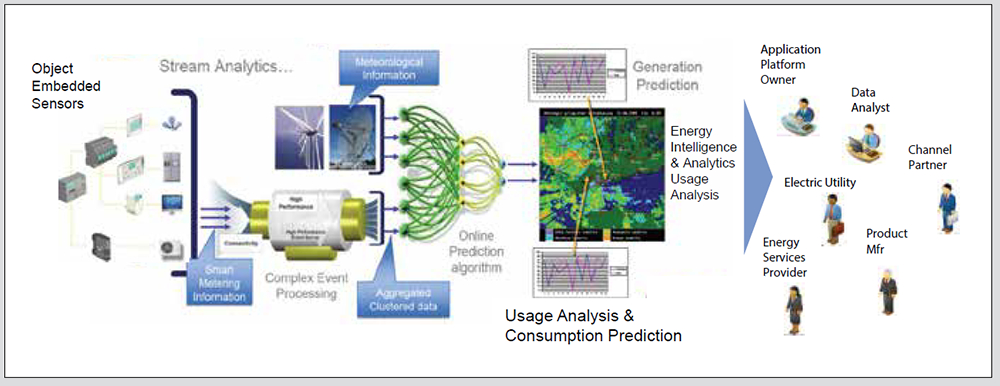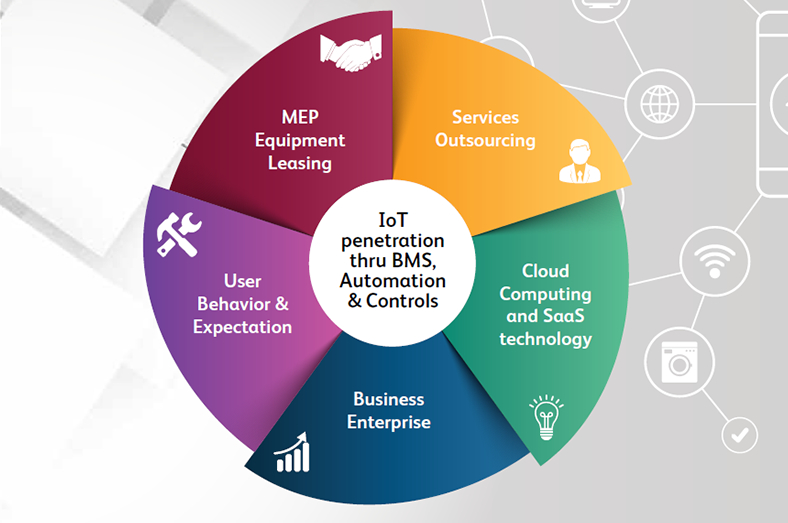Looking at IoT through the automation and controls lens, Vijay Kumar of Cylon makes a compelling case for adopting it in the MEP industry. He believes that we’ll miss the bus if we’re not quick to appreciate the power of IoT in the way the industry is poised to evolve.
− By Vijay Kumar
Internet of Things (IoT) – one wonders if the term has become more ubiquitous than the technology it represents. In the context of the MEP industry, IoT penetration has remained a pipe dream. So is this limitation attributable to technology, or due to inconsistent user expectations or on account of industry’s resistance to change? This article examines these issues from an automation and controls perspective. When collectively addressed, the true benefits of IoT will be experienced by every stakeholder in the MEP industry.
So let us start by recognising the basic components of IoT – an array of digital microprocessors and sensors embedded into everyday objects. Then there is the aspect of connecting these objects into a network, typically using a wired or wireless media. Finally, you have an application platform that analyses the data from these objects and converts that into usable information, which is relayed back to the users of those objects via smart devices. All this should sound familiar to people who have used automation and controls systems, the difference being that IoT scales this up to the nth degree to every walk of life, thanks to rapid growth of Information and Communications technology.
Since several decades, major progress has been made in the field of automation and controls, notably Building Management Systems (BMS), resulting in sensors and digital controllers connected to every conceivable electromechanical equipment.

Interconnectivity using different types of physical or wireless networks backed by an industry-recognised open communication protocol (the ISO standard BACnet) has made it easier to push and pull data across disparate systems. Software applications are available across a variety of platforms, usually in the form of locally installed BMS software, complemented with cloud-based energy and facility management applications. Eventually, the relevant information is pushed back in real-time to the user over smart phones and tablets.
Thus, the basic components of IoT already exist in our industry, which eliminates limitation of technology as a factor for the lack of penetration. The scalability of BMS installations to deliver full-fledged IoT functionality is within reach; however, this has been inadvertently overlooked by our industry. It does make a compelling argument that not enough awareness has been created to associate IoT with automation and controls in the MEP industry.
Why are cloud-based solutions, costing a fraction of localised solutions, still shunned by our industry?
How about user expectations and the resistance to change? Could these factors have been more significant than acknowledged before?
Think about how many of us perform a google search before visiting our doctor for an ailment. We actually think we know what the problem is and we just want validation from our doctor! We live in an information world, where it’s easy to form wrong expectations by misinterpreting data. That is really the crux of the problem – not fully appreciating the power of IoT in the context of the future of our industry and how it’s poised to evolve. So let’s take a peek into the future:
Research shows that four factors will combine to dramatically change the dynamics, economics and competitive landscape of MEP industry over the next decade (source: Harbor Research)
The restructuring of the global economy is an ongoing process driven by the worst economic downturn in 70 years, coupled with the technology changes of cloud computing and software-as-a-service (SaaS), which is bound to undermine the validity of traditional MEP business models. Consequently, our industry is poised to adopt leasing (equivalent of outsourcing in the IT industry) as the preferred option over today’s capital-intensive practices. Ever imagined the leasing of chillers, AHUs or lighting equipment?

In the near future, innovative changes to business enterprise will be much more severe and disruptive than we’ve seen over the past 15 years in terms of service lines offered, buying habits, key stakeholders, pricing and delivery models. Research shows that technology services will be recast as follows, driven by the pace of technology evolution (source: Harbor Research):
All this would then be a perfect opportunity for an open “state-based” platform(s) that allows equipment usage and performance to be monitored and controlled in real-time, and then be charged to customers on pay-per-use basis. Of course, we already know that these are the core functionalities of automation and controls systems. Thus, one can see how a scaled-up version of today’s BMS technology, by leveraging the gains of Information and Communications technology, deliver the full potential of IoT for the MEP industry from a near-term standpoint.
The scalability of BMS installations to deliver ful
l-fledged IoT functionality is within reach
To adopt this visualisation, what is required is a true shift in thinking about how people, physical systems and smart devices can be integrated in the MEP world. Resistance to change comes in various forms, encompassing economics and technology. Why else are cloud-based solutions, costing a fraction of localised solutions, still shunned by our industry? Just as the future augers pay-per-use equipment model, it also augers software-as-a-service and platform-as-a service to maximise capital savings for users.
A functionality of IoT that is often overlooked is its potential contribution to smart buildings and smart cities, whose stated objective is to maximise the happiness of its occupants and citizens. Imagine the happiness of parents when their wards perform better at school, thanks to IoT working silently away in the background correlating class performance, attendance and indoor air quality data to identify and then eliminate electromechanical problems in classrooms that’ve fallen behind the school average! Just another example how IoT, automation and controls come together to deliver huge benefits to the common man.
In conclusion, IoT is already at our doorstep and knocking on our industry doors. Automation and controls, in the form of open protocol BMS and cloud-based solutions, have accelerated this arrival. We, the industry stakeholders, only need to open the door.
CPI Industry accepts no liability for the views or opinions expressed in this column, or for the consequences of any actions taken on the basis of the information provided here.
Vijay Kumar is President for International Business at Cylon Controls. He can be contacted at Vijay.Kumar@cylon.com
Copyright © 2006-2025 - CPI Industry. All rights reserved.